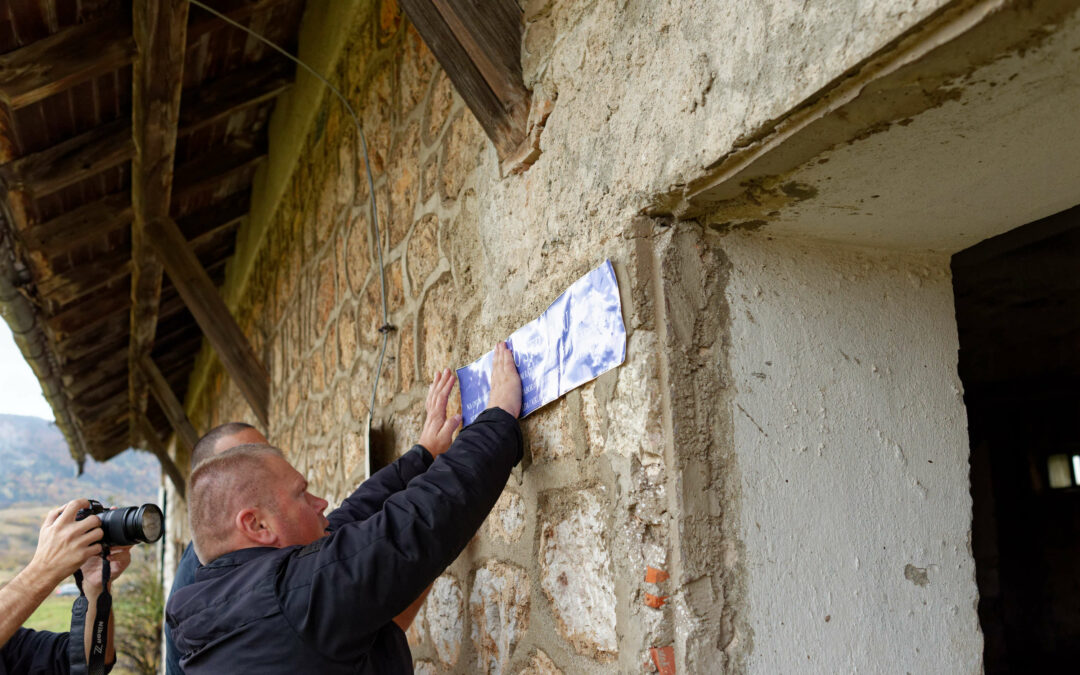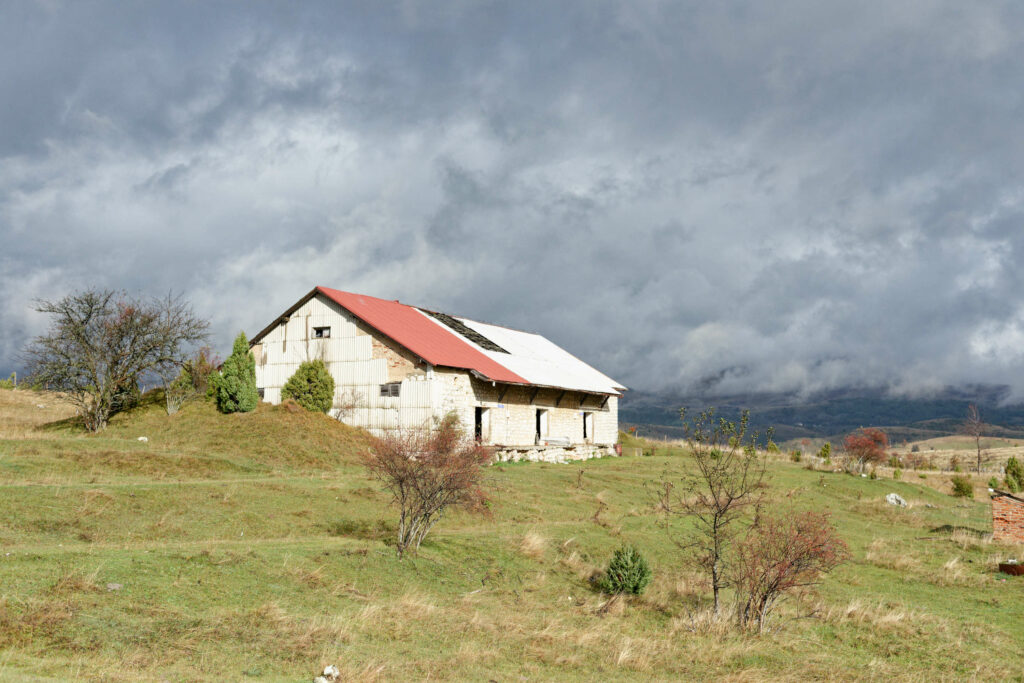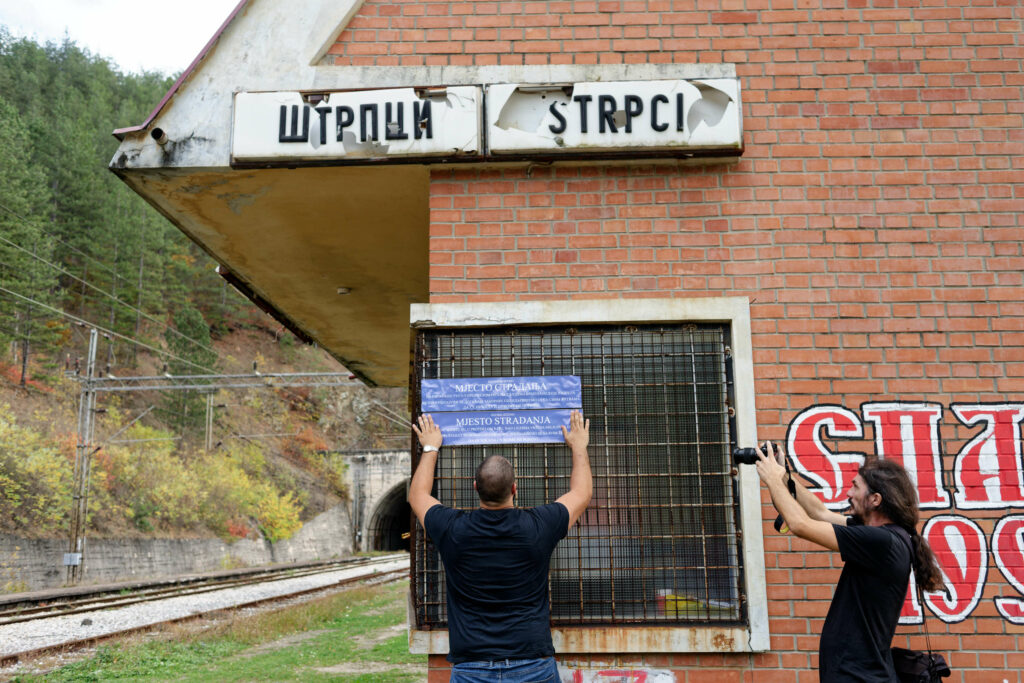With the support of the Centre for Nonviolent Action Sarajevo-Belgrade, activists from Bosnia and Herzegovina marked unmarked sites of suffering in the area of Hrasnica in Ilidža, the wider Kalinovik area and the Štrpci railway station near Rudo.
The railway station in Štrpci near Rudo has still not been marked as the site where 20 passengers were abducted. With the help of the Centre for Nonviolent Action Sarajevo-Belgrade, activists from Bosnia and Herzegovina have been trying to right that wrong by mapping and marking unmarked sites of suffering. In their 19th action, they marked two sites that used to be detention facilities under the control of ARBiH in the area of Hrasnica near Ilidža, detention facilities and sites of execution and mass graves of Bosniak victims in the wider Kalinovik area, and the Štrpci railway station near Rudo where members of the Osvetnici paramilitary formation abducted twenty non-Serb passengers from the train travelling from Belgrade to Bar in 1993, took them to Mušići where they killed them and then threw their bodies into Lake Perućac.
In the Kalinovik area, the activists were joined by Amer Kadić from the “Istina Kalinovik ‘92” association that aims to mark detention facilities for Bosniaks and sites of executions and mass graves in the Kalinovik area.
“The Gunpowder Warehouse that we just marked was where 80 people from the Kalinovik area were imprisoned, mostly men, they were tortured and then taken by trucks to a site at Mehka brda and other sites where they were killed. There is no memorial here because this is military property, partly municipal, and we have no possibility of reaching an agreement with the Kalinovik Municipality. Each year, the association comes here to organise a commemoration in memory of this and other sites, and we will persevere in these efforts as long as we exist,” Kadić said, adding that for them and the whole of Kalinovik, it would be a big step forward if these sites were marked in a dignified manner. Unable to install a permanent memorial, the survivors and families of the killed have marked some of the sites, especially those in wooded areas, with old tires, paint and in various other ways. Apart from the Gunpowder Warehouse, the activists also marked execution and mass grave sites on the Rogoj Pass and at Mehka brda near Kalinovik.
For crimes committed in the Kalinovik area, the Court of BiH convicted Ratko Bundalo, sentencing him to 19 years in prison, while Neđo Zeljaj was sentenced to 15 years and Đorđislav Aškraba to 7 years in prison. Ratko Mladić, Momčilo Krajišnik and Biljana Plavšić were convicted for crimes committed in Kalinovik by the ICTY.
Several facilities in Hrasnica near Ilidža were used from 1992 to 1994 as detention facilities for Serb soldiers and civilians. The facilities were run by ARBiH and the prisoners were kept in inhumane conditions and subjected to abuse, beatings and killings. In this action, the activists marked two sites of detention in Hrasnica: the basement near a high-rise and the nearby garages. Husein Mujanović was convicted for crimes in the area of Hrasnica by the Court of Appeals in Belgrade and sentenced to four years and six months in prison. In its first-instance judgement, the Court of Bosnia and Herzegovina acquitted Senad Gadžo, Zaim Lalić and Suljo Hebib of charges for crimes against civilians in Hrasnica.
“We have been conducting these activities in Bosnia and Herzegovina since 2015 and we have marked 140 sites to date. This initiative aims to encourage an inclusive culture of memory and dealing with the past. There is no sign at this station to say what actually happened here and to serve as a warning to future generations. It means a lot for me personally to be part of this initiative, because I am participating in something that creates a positive change in Bosnian-Herzegovinian society and the region. After years and years of an exclusive culture of memory where different victims were never part of the same memory, we have decided to approach all victims equally,” said Dalmir Mišković, one of the activists. Activists also visited the site of suffering in the village of Bavčići near Goražde and had a preparatory meeting with the local victims’ association. This site of suffering has since been marked by a permanent memorial, but the victims’ association is still calling on relevant institutions to investigate the crimes and prosecute the perpetrators.
On 27 February 1993, train No. 671 was travelling from Belgrade to Bar and stopped in Štrpci where members of the Osvetnici paramilitary formation abducted twenty non-Serb passengers that they then killed in Mušići and threw their bodies into Lake Perućac, which is located in the territory of Bosnia and Herzegovina (BiH). The victims were citizens of Prijepolje, Bijelo Polje, Belgrade and Podgorica. The oldest was 59 and the youngest 16 years old. To date, the remains of only four victims have been found.
In 2020, together with a mixed group of war veterans from BiH, Croatia and Serbia, the Centre for Nonviolent Action Sarajevo-Belgrade honoured the victims abducted in Štrpci at the official commemoration that is held each year in Prijepolje, Serbia.
“Unfortunately, most of the families never found the bodies of their loved ones. Sites of crimes must be disclosed on all three sides and properly marked so that future generations can learn about what happened in these terrible times and so that it never happens again,” said Krsto Rakić, a war veteran and peace activist from Rudo who joined the activists in Štrpci.
Mesud Kumro, a war veteran and peace activist from Goražde, says that feeling are always mixed when visiting these and similar sites.
“There’s a feeling of sorrow and anger that such a grave crime could happen, that people could be killed just because of their names. I am glad that I can participate in these activities, I am proud that I have taken part and visited sites of crimes against all the different people,” Kumro said. Both in Prijepolje in 2020, and again in Štrpci, the peace activists were also joined by Suljo Đogo, another veteran from Goražde.
“I am sorry that this place has not been marked, but we are here today to mark it as best we can. Our mission is to sympathise with all victims and their families and to show our humanity towards all victims. We have visited many sites of atrocities and viewed every victim the same, and every perpetrator, and that is our mission,” Đogo said.
Obrad and Novak Poluga, Petko Inđić, Radojica Ristić, Dragan Šekarić, Oliver Krsmanović and Miodrag Mitrašinović were convicted by the Court of BiH and sentenced to 13 years in prison each for their part in the killing of 20 civilians taken from the train at the station in Štrpci. The Court of Bosnia and Herzegovina also sentenced Boban Inđić to 15 years in prison for the same crime. The International Criminal Tribunal for the former Yugoslavia sentenced Milan Lukić to life imprisonment for crimes committed in Višegrad, while the Court of BiH raised an indictment against him in 2020 for crimes committed in Štrpci, which he refused to receive in Estonia where he is serving his sentence, while Nebojša Ranisavljević was sentenced to 15 years in prison in Montenegro. The High Court in Belgrade delivered a first-instance judgement on 7 February 2023, sentencing the accused Gojko Lukić, Duško Vasiljević and Jovan Lipovac to 10 years in prison each, while Draga Đekić was sentenced to five years in prison for the abduction of passengers from the train in Štrpci.
With this 19th action, we have brought the total number of marked sites of suffering in BiH to 140. A list of marked sites with information about crimes and prosecutions, as well as a map of the sites of suffering are available on our website onms.nenasilje.org.
Video from action:





